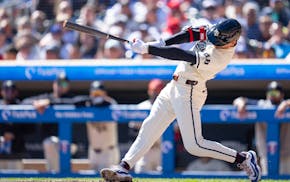Several Timberwolves players and staffers this summer went on a retreat in the Bahamas, the centerpiece of an offseason working not just on togetherness off the court but cohesiveness on the court.
It paid off early on, with the Wolves jumping out to a surprising 10-8 start and garnering playoff talk. Since then? They are 5-27, and this week they made a series of trades that dramatically overhauled their roster — much as Gersson Rosas had pledged to do when taking over as president of basketball operations nine months ago.
Seven new players took the stage at various points Friday for an introduction and comments to local media and fans. The biggest immediate questions: Without the benefit of training camp, what's fair to expect over the final 32 games of the season, and what will this look like on the court?
"This is one practice, and then we play," Rosas said Friday, acknowledging players will be learning on the fly before facing the Clippers at Target Center on Saturday.
As far as expectations go, it starts with effort level. Coach Ryan Saunders mentioned playing with an "underdog" mentality given the Wolves' record, 13-game losing streak and fresh starts for several newcomers who should see an increased role with their new team.
"This is going to be a hard-playing group that plays tough every night," Saunders said.
More important, though, is the answer to what this will look like on the court. The short answer: Probably a lot like the first 50 games, systemwise — but hopefully a lot better resultswise.
Even throughout two long losing streaks this year, Rosas and Saunders have remained steadfast in the approach the Wolves are taking by implementing an up-tempo offensive system that rewards efficiency.
"To me, it's their ability to get up and down the floor," Saunders said in explaining part of why the remade roster will be a better fit.
Rosas said he knew "May 1st," which is the day he was hired, that he had a lot of work to do — more work than he could accomplish in one offseason, particularly with salary cap issues — to find the types of players to fit that system.
"We needed to know what we had and what we needed," Rosas said.
Given that only Karl-Anthony Towns and Josh Okogie remain from the roster Rosas inherited nine months ago, the answer is pretty blunt.
Several newcomers should fit better. Malik Beasley and Juancho Hernangomez, both of whom came from Denver in the four-team Robert Covington trade and could see the most playing time among the additions not named D'Angelo Russell, can both play fast and shoot three-pointers.
Beasley, a shooting guard, is a career 38.2% shooter from beyond the arc and figures to try about seven per game if given starter's minutes.
Hernangomez, a power forward, could be a good fit next to Towns — as is Omari Spellman, another power forward with range (36.6% from three for his career) who came with Russell from Golden State.
Oh yeah, and Russell: He's shooting 37.4% on 9.7 attempts per game from deep this year.
Those are welcome numbers for a team that traded one of its best shooters (Covington) and ranked third in the NBA in three-point attempts per game (39.4) but tied for last in three-point shooting (32.5%).
"We've been very strong in what we believe in here," Saunders said. "If the process is right, we can live with the outcome."
Maybe now, as new players get acclimated, better outcomes will follow the process.

Live: Minnesota United at Charlotte FC. Follow on Gameview.
T-wolves take NBA's best defense into series vs. Suns, but can it stop Durant-Booker-Beal trio?

